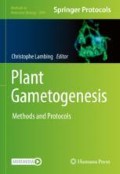Abstract
Metabolite profiling aiming at quantifying the metabolome of flowers is emerging as a suitable tool to understand the metabolic complexity of these reproductive organs and the associations between primary and secondary metabolites which characterize them. This chapter provides a general method for the combined analyses of primary and secondary metabolites via gas chromatography–mass spectrometry (GC-MS) and high-performance liquid chromatography–mass spectrometry (LC-MS) of flower samples. We describe the preparatory steps, the procedure of metabolites’ extraction and finally provide examples of data representation. The method described here can be applied to the analysis of metabolomes of entire flowers, as well as specific flower organs.
Access this chapter
Tax calculation will be finalised at checkout
Purchases are for personal use only
References
Misra CS, Santos MR, Rafael-Fernandes M et al (2019) Transcriptomics of Arabidopsis sperm cells at single-cell resolution. Plant Reprod 32(1):29–38
Palovaara J, Weijers D (2020) Cell type-specific transcriptomics in the plant embryo using an adapted INTACT protocol. In: Plant metabolomics, Methods mol biol, vol 2122, pp 141–150
Chen D, Yan W, Fu L-Y et al (2018) Architecture of gene regulatory networks controlling flower development in Arabidopsis thaliana. Nat Commun 9(1):1–13
Mergner J, Frejno M, Messerer M et al (2020) Proteomic and transcriptomic profiling of aerial organ development in Arabidopsis. Sci Data 7(1):1–11
Dafny-Yelin M, Guterman I, Menda N et al (2005) Flower proteome: changes in protein spectrum during the advanced stages of rose petal development. Planta 222(1):37–46
An D, Chen J-G, Gao Y-Q et al (2017) AtHKT1 drives adaptation of Arabidopsis thaliana to salinity by reducing floral sodium content. PLoS Genet 13(10):e1007086
Li D, Heiling S, Baldwin IT et al (2016) Illuminating a plant’s tissue-specific metabolic diversity using computational metabolomics and information theory. Proc Natl Acad Sci 113(47):E7610–E7618
Tohge T, Borghi M, Fernie AR (2018) The natural variance of the Arabidopsis floral secondary metabolites. Sci Data 5:180051
Borghi M, Fernie AR (2017) Floral metabolism of sugars and amino acids: implications for pollinators’ preferences and seed and fruit set. Plant Physiol 175(4):1510–1152
Borghi M, de Souza LP, Yoshida T et al (2019) Flowers and climate change: a metabolic perspective. New Phytol 224(4):1425–1441
Borghi M, Fernie AR (2020) Outstanding questions in flower metabolism. Plant J 103:1275–1288
de Souza LP, Fernie AR, Tohge T (2018) Carbon atomic survey for identification of selected metabolic fluxes. In: Plant metabolomics, Methods mol biol, vol 1178. Springer, pp 59–67
Lima VF, de Souza LP, Williams TC et al (2018) Gas chromatography–mass spectrometry-based 13 C-labeling studies in plant metabolomics. In: Plant metabolomics, Methods mol biol, vol 1178. Springer, pp 47–58
Osorio S, Do PT, Fernie AR (2011) Profiling primary metabolites of tomato fruit with gas chromatography/mass spectrometry. In: Plant metabolomics, Methods mol biol, vol 860. Springer, pp 101–109
Shimizu T, Watanabe M, Fernie AR et al (2018) Targeted LC-MS analysis for plant secondary metabolites. In: Plant metabolomics, Methods mol biol, vol 1178. Springer, pp 171–181
Acknowledgments
The authors gratefully acknowledge the financial support of the Max Planck Society and Utah State University startup funding to M.B.
Author information
Authors and Affiliations
Corresponding author
Editor information
Editors and Affiliations
Rights and permissions
Copyright information
© 2022 The Author(s), under exclusive license to Springer Science+Business Media, LLC, part of Springer Nature
About this protocol
Cite this protocol
Borghi, M., Perez de Souza, L., Fernie, A.R. (2022). Measurement of Flower Metabolite Concentrations Using Gas Chromatography–Mass Spectrometry and High-Performance Liquid Chromatography–Mass Spectrometry. In: Lambing, C. (eds) Plant Gametogenesis. Methods in Molecular Biology, vol 2484. Humana, New York, NY. https://doi.org/10.1007/978-1-0716-2253-7_1
Download citation
DOI: https://doi.org/10.1007/978-1-0716-2253-7_1
Published:
Publisher Name: Humana, New York, NY
Print ISBN: 978-1-0716-2252-0
Online ISBN: 978-1-0716-2253-7
eBook Packages: Springer Protocols

